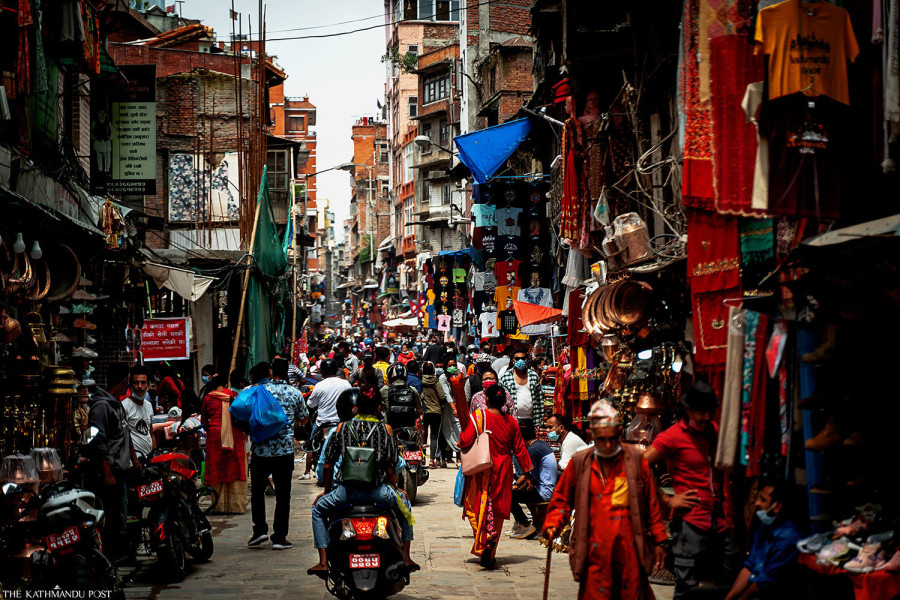Valley
With majority population unvaccinated, concerns abound over hasty lifting of Covid-19 restrictions
Covid-19 Crisis Management Centre says it is devising a strategy to tackle a possible third wave.
Anup Ojha
Shishir Thakuri works at a printing press at Putalisadak in the Capital. Like a majority of Nepalis, he has not received a Covid-19 vaccine yet. His job requires working with half a dozen colleagues in a small room and he attended his office regularly even during the two-month-long strict lockdown.
It was not easy for him to follow the health protocols such as maintaining social distance. But after the Valley’s chief district officers eased the prohibitory orders this Tuesday, allowing a full-fledged operation of public vehicles, he started feeling panicked.
“I hear that cases are surging again, and Putalisadak over the past few days has been so crowded that I am scared to go out for lunch,” said Thakuri, 24.
“Except for the press owner, none of us are vaccinated so we fear contracting the virus,” said Thakuri, who hails from Dadeldhura district and is staying with his cousin at Ghattekulo.
Sarita Bhattarai, 55, of Boharatar hasn’t been vaccinated either. She started going back to her office at the Balaju Industrial District Management Office two weeks ago. She was diagnosed with breast cancer two years ago and falls in the high-risk category for Covid-19 infection.
“I had gone to a vaccination centre to get the first dose two months ago but after seeing the long line, I decided to return home,” said Bhattarai.
Thakuri and Bhattarai represent around 22 million Nepalis who have yet to be vaccinated. The Ministry of Health and Population’s data show that 2.61 million people have so far received the first dose of the coronavirus vaccine and of them 933,868 have received both doses.
Similarly, some 1.4 million elderly citizens who were inoculated with the Covishield vaccine in March are yet to get their second dose.
With the reopening of shops and businesses and resumption of public transport, public mobility has increased markedly in the Valley, but at the same time violation of Covid-19 safety protocols has also increased. Public vehicles are carrying passengers beyond their seating capacities, streets and business hubs are crowded and restaurants are providing dine-in services.
“With the easing of restrictions, crowding has increased in the Balaju industrial district and many people are not even wearing masks or observing social distancing. I am more anxious than ever about the virus,” said Bhattarai.
It is not just there is more movement of people. Political protests are also ongoing. The student wings of the five parties in the opposition alliance organised whistle rallies in all 77 districts across the country on Thursday. They also demonstrated at the office of the Nepal Oil Corporation in Kathmandu against its decision to hike fuel prices.
Rajib Dhungana, president of Nepali Congress affiliated Nepal Students Union, said they will continue to continue the demonstrations.
“We cannot stay idle when Prime Minister KP Sharma Oli is taking one step after another against the constitution and the rule of law,” he told the Post. “We are aware of the pandemic. We follow the safety protocols and social distancing.”
Meanwhile, a high number of infections with a high positivity rate continues.
On Wednesday, Nepal reported 2,077 new cases of Covid-19 from a total of 7,835 polymerase chain reaction tests in the past 24 hours, putting the infection rate at 26.5 percent. Compared to the past six days, the infection rate has increased by five percent. The government’s report on July 2 showed that out of 6,566 polymerase chain reaction tests, 1,391 new cases were reported which is 21.18 percent.
“If the crowding continues with no proper mechanism to check the spread of the virus, the situation in the Kathmandu Valley can become uncontrollable,” warned Dr Baburam Marasini, former director at the Epidemiology and Disease Control Division.
“The transmission risk is still very high but the government has decided to reopen almost all sectors and people are behaving as if there is no virus. The government failed in its duty to warn the public that the threat has not gone yet.”
Marasini alleges that a lack of proper coordination among the three tiers of government is responsible for the current chaos.
Khim Lal Devkota, a national assembly member who holds a PhD on development economics, agrees.
“The problem we have is the result of the tussle between Home Ministry and the Health Ministry over handling the pandemic, Prime Minister KP Sharma Oli’s government giving all the powers to the chief district officers and a lack of coordination among government agencies,” said Devkota.
The Epidemiology and Disease Control Division has already confirmed that the Delta and Delta Plus variants of the coronavirus have been circulating in the country. It is reported that both sub-lineages of the virus are highly contagious. Research suggests that the Delta variant, officially known as B.1.617.2, is the most contagious of all the known variants to date, possibly 40 to 60 percent more transmissible than the Alpha variant, though studies are ongoing.
When inquired about the threat of the new variants of the coronavirus, Kathmandu’s Chief District Officer Kali Prasad Parajuli said his office is set to consult the Health Ministry and will revise the prohibitory orders accordingly.
Dhundi Prasad Niraula, chief district officer of Lalitpur, said his office is closely watching the situation. “We are holding a meeting with the Covid-19 Crisis Management Centre by Monday and may come up with a new decision,” he said.
When asked about the allegations of lack of coordination among various tiers of government and agencies in dealing with the virus, Krishna Hari Pushkar, spokesperson at the Covid-19 Crisis Management Centre, said his office has been working for an improved coordination.
"Next week we will be consulting with all the local units and stakeholders to devise a strategy in view of a possible third wave," he said.




 18.12°C Kathmandu
18.12°C Kathmandu.jpg)










